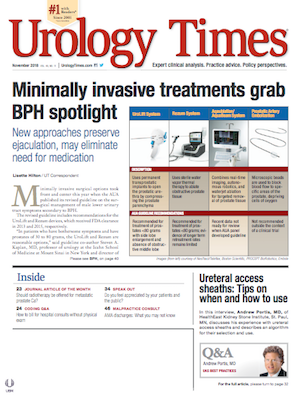Publication
Article
Urology Times Journal
As 2019 nears, focus on these financial planning tasks
Author(s):
Take time to review your emergency fund and max out retirement account contributions.
What are some financial planning tasks I should focus on before year end?
The quickly approaching year end presents the perfect opportunity to review and possibly adjust your financial planning strategies. A lot can happen in a year, and you should be updating your accounts and checking in on where you stand with many of the goals you set at the beginning of the year.
Check on the status of your emergency fund. Did you need to dip into it at all this year? Have your necessary expenses changed? It’s always a good idea to review the balance of the account as well as your budget to see if additional funds need to be added to bolster the account. The general rule of thumb for emergency funds is to have 3 months of necessary expenses if you are a dual-income household and 6 months to a year if you are a single-income household.
Also from Jeff Witz, CFP - 401(k) with a previous employer: What are your options?
Max out your retirement accounts. You have until the tax filing date next spring to make a 2018 contribution to an individual retirement account (IRA), but 401(k) and 403(b) contributions are only deductible when made in the same calendar year. The 2018 contribution limit is $18,500 for 401(k)s and 403(b)s and $5,500 for IRAs. If you are over age 50, catch-up contributions may be available as well.
Use the remaining money in your Flexible Spending Accounts. If you still have money set aside in a flexible spending account for health care or dependent care expenses, it is important to try and use those funds before the end of the year or risk forfeiting the money. Some employers offer a grace period into the spring of the next year or a $500 flexible spending account carry-over from 1 year to the next, but most do not.
Make contributions into your children’s 529 accounts. College costs continue to rise, and it is important to start saving early if you hope to reach your college funding goals. Additionally, in some states, a state income tax deduction is offered to residents who contribute to their 529 plan. In some cases, the tax savings can be substantial.
Next: Designate those individuals to whom you wish to gift assetsDesignate those individuals to whom you wish to gift assets. The annual gift tax exclusion is $15,000 for 2018 ($30,000 for married couples). You can gift this amount to any number of individuals without having to pay gift tax or have it count against your lifetime gift and estate tax exemption.
Make charitable donations. Giving to charity can be a very powerful tax-savings tool. Check and see if you have any appreciated investment assets that you could gift instead of cash. This way, you avoid paying capital gains taxes on those investments and are able to claim a deduction for the full value of the donated asset. When the charitable organization sells it, there's no tax to them. Be aware, however, that under the new tax law, you may need to donate a substantial amount of assets to be eligible for a charitable deduction on your taxes.
Read: How can rising interest rates affect your bond portfolio?
These are just a handful of financial issues to consider as we approach year end. Your financial and legal advisers can run through a more comprehensive checklist of planning options based on your personal circumstances.
My 401(k) has a vesting schedule. What does vesting mean?
Many employer-sponsored retirement plans have a vesting schedule to incentivize employees to remain with the company long term. Vesting refers to ownership and means that, even if your employer made matching contributions, you may not fully own those assets yet. While you are always 100% vested in the salary deferral contributions you make to the plan, ownership of employer contributions is gained over time.
Vesting schedules may be graded, giving you increased ownership of employer contributions each year. For example, after 1 year of service you may be 20% vested and after year two, 40%, and so on until you are 100% vested. Graded schedules can be no longer than 6 years.
Alternatively, the plan may have a cliff vesting schedule. Just like it sounds, this provision means that for a certain period of time, you won’t be vested at all. Then, like going off a cliff, you become 100% vested all at once. If your employer selects a cliff vesting schedule, the cliff can be no longer than 3 years of service. With either type of vesting schedule, the definition of service can vary, so be sure to read the plan document.
Mr. Witz is educational program director at MEDIQUS Asset Advisors, Inc. in Chicago. He welcome readers’ questions and can be reached at 800-883-8555 or witz@mediqus.com.
The information in this column is designed to be authoritative. The publisher is not engaged in rendering legal, investment, or tax advice.





















